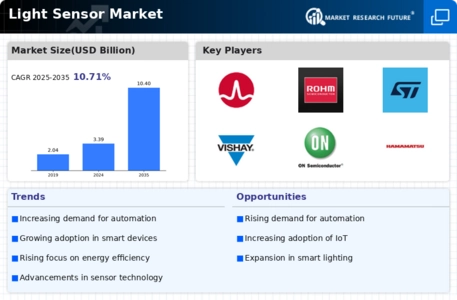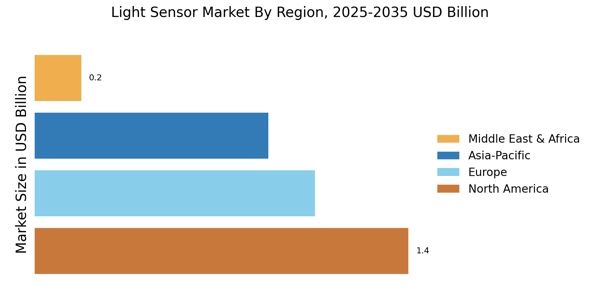Expansion of Smart Home Applications
The expansion of smart home applications is a significant driver for the Light Sensor Market. As more consumers embrace smart home technologies, the integration of light sensors into home automation systems is becoming commonplace. These sensors facilitate automated lighting control, enhancing convenience and energy efficiency. Recent market analyses suggest that the smart home market is projected to exceed USD 150 billion by 2025, with light sensors playing a vital role in this growth. The ability to control lighting through mobile applications and voice commands is appealing to consumers, further driving the adoption of light sensors in residential settings. This trend is likely to bolster the Light Sensor Market as manufacturers innovate to meet the evolving demands of smart home consumers.
Growing Awareness of Energy Conservation
The heightened awareness surrounding energy conservation is significantly influencing the Light Sensor Market. As consumers and businesses alike become more conscious of their energy consumption, the demand for energy-efficient solutions is surging. Light sensors play a crucial role in optimizing energy use by automatically adjusting lighting based on occupancy and natural light levels. Recent statistics indicate that buildings equipped with light sensors can achieve energy savings of up to 30%. This trend is likely to drive investments in light sensor technologies, as organizations strive to meet sustainability goals and reduce their carbon footprint. Consequently, the Light Sensor Market is poised for growth as more entities recognize the value of integrating these sensors into their energy management strategies.
Rising Demand for Smart Lighting Solutions
The increasing adoption of smart lighting solutions is a pivotal driver for the Light Sensor Market. As urbanization accelerates, cities are seeking innovative ways to enhance energy efficiency and reduce operational costs. Smart lighting systems, which utilize light sensors to adjust brightness based on ambient light conditions, are gaining traction. According to recent data, the smart lighting market is projected to reach USD 30 billion by 2026, indicating a robust growth trajectory. This trend is likely to propel the demand for light sensors, as they are integral to the functionality of these systems. Furthermore, the integration of Internet of Things (IoT) technology in lighting solutions is expected to further stimulate the Light Sensor Market, as it allows for remote monitoring and control.
Increased Adoption in Industrial Automation
The increased adoption of light sensors in industrial automation is a key driver for the Light Sensor Market. Industries are increasingly leveraging automation to enhance operational efficiency and reduce costs. Light sensors are integral to various automated processes, including quality control, safety monitoring, and energy management. For example, in manufacturing environments, light sensors can detect changes in ambient light to optimize machine performance and energy consumption. The industrial automation market is expected to grow significantly, with light sensors being a critical component in this evolution. This trend suggests a robust future for the Light Sensor Market, as industries continue to seek innovative solutions to improve productivity and sustainability.
Technological Advancements in Sensor Technology
Technological advancements in sensor technology are propelling the Light Sensor Market forward. Innovations such as miniaturization, enhanced sensitivity, and improved accuracy are making light sensors more effective and versatile. These advancements enable the development of new applications across various sectors, including automotive, consumer electronics, and industrial automation. For instance, the automotive sector is increasingly incorporating light sensors for adaptive lighting systems, which enhance safety and driving comfort. The market for automotive light sensors is expected to grow at a compound annual growth rate of 10% over the next five years. Such developments indicate a promising future for the Light Sensor Market, as enhanced sensor capabilities open new avenues for growth and application.

















Leave a Comment